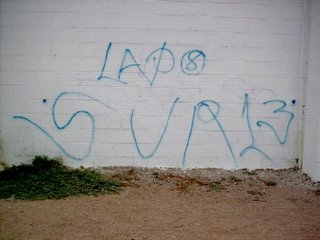
Last year I had the opportunity to go and train members of CIPOL in Chihuahua Mexico on gang recognition and intelligence gathering. While the specific gang identifiers there were somewhat different from those found in the United States, the general dynamics of gang structure, identifiers, and overall make-up are almost identical. During the trip I was able to assist police in interviewing gang members on the streets. What follows below are excerpts from the assessment I completed for the authorities there in the city. This sheds light on how gangs have become a global problem. It also demonstrates how despite different identities of gangs and different identifiers being present, a generalized understanding of gangs proves effective in gang intelligence gathering regardless of the place gangs are located. Foremost it reveals that gang training on local gang ecology is essential in dealing with gangs in any community.
Gang / Deviant Groups in Chihuahua Mexico
Preliminary Assessment

During the week of July 10 through July 16, 2005 intelligence gathering and assessment of the gang / deviant groups subculture in Chihuahua Mexico revealed several key elements taking place in the area. In the preliminary assessment no major super groups could be readily identified, however, there is some indication that such groups may be operating on a peripheral basis.
Localized Gangs and Growing Alliances:
Localized Gangs appear to be the predominant subculture across the city. Some localized gangs already appear to be evolving into more widespread groups. Los Aldeas, Barrio Londres, Los Diablos 21, Septima and BSK were identified as groups having graffiti across the city as opposed to one or two specific generalized locations. Intermediate alliances between some groups as Los Diablos 21, Septima, Los Aldeas and some other local groups under the banner Sur 13 is indicated by interviews with Septima and other members. Further evaluation is needed to ascertain the relevance and strength of such alliances.
Groups of Interest: Dukes / Sur 13
Of particular interest groups such as the Dukes appear to have a growing and predominant presence across several barrios. The Dukes could be tied to the same group in the US but further assessment and interviews with gang members in the Chihuahua area will be needed to ascertain if this is the same group. Whether tied to the US group or not, the Dukes seem to have an extensive presence in the city and from graffiti dates also appear to have been in the city for quite some time.
appear to have a growing and predominant presence across several barrios. The Dukes could be tied to the same group in the US but further assessment and interviews with gang members in the Chihuahua area will be needed to ascertain if this is the same group. Whether tied to the US group or not, the Dukes seem to have an extensive presence in the city and from graffiti dates also appear to have been in the city for quite some time.
Sur 13 is especially noted because it is a known marker of the Southern California alliances between the Mexican Mafia, their cooperative of localized barrio gangs, and Mara Salvatrucha. Sur 13 is not necessarily a specific gang group but rather a group identity not unlike the Folk or People Nation Super Gangs in the United States. The Sur 13 identity appears to be in the preliminary stages of the same amalgamation process as the Folk / People Nation groups were approximately 20 years ago. Security and financial reasons are identified as catalysts for the Super Gang / Nation Gang umbrella organizations that evolved. That same process appears to be ongoing with the Hispanic gangs not already directly tied to either of the aforementioned Nation groups.
The assessment of the culture in the Chihuahua area appears to indicate that unless intervention is initiated such conglomeration of local groups into larger umbrella groups is imminent as evidence indicates is already underway. Further cooperation and amalgamation of Sur 13 and related identities into Folk or People Nation Super Gangs could also result in the near future in the United States making the threat of the Nation Gangs even greater.

 appear to have a growing and predominant presence across several barrios. The Dukes could be tied to the same group in the
appear to have a growing and predominant presence across several barrios. The Dukes could be tied to the same group in the 



<< Home